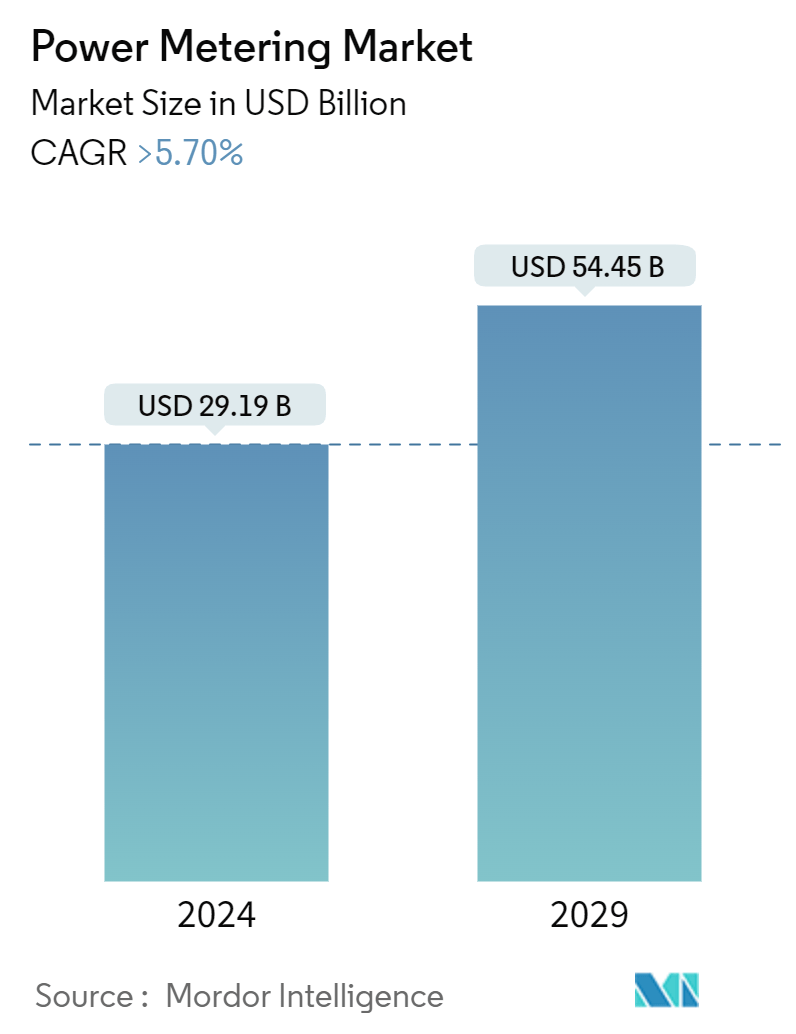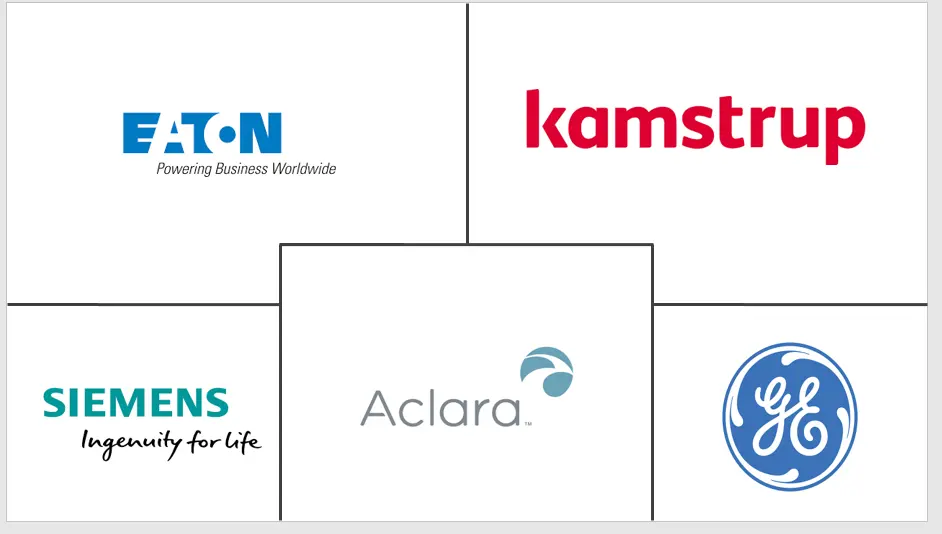Market Size of Power Metering Industry

| Study Period | 2019 - 2029 |
| Market Size (2024) | USD 29.19 Billion |
| Market Size (2029) | USD 54.45 Billion |
| CAGR (2024 - 2029) | > 5.70 % |
| Fastest Growing Market | Asia Pacific |
| Largest Market | North America |
| Market Concentration | Medium |
Major Players
*Disclaimer: Major Players sorted in no particular order |
Power Metering Market Analysis
The Power Metering Market size is estimated at USD 29.19 billion in 2024, and is expected to reach USD 54.45 billion by 2029, growing at a CAGR of greater than 5.70% during the forecast period (2024-2029).
- Over the medium term, factors such as the increasing government focus on developing smart grid infrastructure and the rising investments in deploying smart meters are expected to drive the power metering market.
- However, issues related to privacy and standardization of power meters may restrain the market’s growth during the forecast period.
- Technological advancements and increasing environmental concerns in conventional infrastructure are also expected to open new growth opportunities in the global market.
- Asia-Pacific is expected to dominate the market, with a majority of the demand coming from China and India.
Power Metering Industry Segmentation
Power metering refers to the process of measuring and monitoring the consumption of electrical energy in a particular system or device. It involves the use of specialized devices, called power meters or energy meters, to measure the amount of electricity consumed accurately.
The power metering market is segmented by end user, technology, and geography. By end user, the market is segmented as residential, commercial, and industrial, and by technology, the market is segmented into analog meters, digital meters, and smart meters. The report also covers the market size and forecasts for the power metering market across major regions. The report offers the market size and forecasts in value for each of the abovementioned segments.
| End User | |
| Residential | |
| Commercial | |
| Industrial |
| Technology | |
| Analog Meters | |
| Digital Meters | |
| Smart Meters |
| Geography | |||||||||||
| |||||||||||
| |||||||||||
| |||||||||||
| |||||||||||
|
Power Metering Market Size Summary
The power metering market is poised for significant growth, driven by increasing government initiatives to develop smart grid infrastructure and the rising investments in smart meter deployment. These advanced metering systems are designed to provide detailed energy consumption data, helping to reduce electricity bills and optimize energy usage. The market is expected to expand as countries replace outdated digital and analog meters with smart meters, supported by government targets and schemes. However, challenges such as privacy concerns and standardization issues may hinder market growth. Technological advancements and heightened environmental awareness are anticipated to create new opportunities, particularly in the Asia-Pacific region, where demand is largely fueled by urbanization in countries like China and India.
The Asia-Pacific region is expected to lead the power metering market, with substantial contributions from China and India. Both countries are heavily investing in smart grid infrastructure, which includes advanced metering technologies, communication networks, and data analytics. These investments are aimed at enhancing energy efficiency, enabling real-time monitoring, and integrating renewable energy sources. The market's expansion is further supported by initiatives in developed countries, such as the United States and Germany, where smart meter installations are on the rise. The semi-fragmented market features key players like Eaton Corporation, Kamstrup AS, Siemens AG, Aclara Technologies, and General Electric Company, all of which are actively involved in advancing smart metering solutions.
Power Metering Market Size - Table of Contents
-
1. MARKET OVERVIEW
-
1.1 Introduction
-
1.2 Market Size and Demand Forecast, till 2029
-
1.3 Recent Trends and Developments
-
1.4 Government Policies and Regulations
-
1.5 Market Dynamics
-
1.5.1 Drivers
-
1.5.1.1 Increasing Government Focus on the Development of Smart Grid Infrastructure
-
1.5.1.2 Increase in Investments to Deploy Smart Meters
-
-
1.5.2 Restraints
-
1.5.2.1 Issues Related to Privacy and Standardization of Power Meters
-
-
-
1.6 Supply Chain Analysis
-
1.7 Porter's Five Forces Analysis
-
1.7.1 Bargaining Power of Suppliers
-
1.7.2 Bargaining Power of Consumers
-
1.7.3 Threat of New Entrants
-
1.7.4 Threat of Substitutes Products and Services
-
1.7.5 Intensity of Competitive Rivalry
-
-
-
2. MARKET SEGMENTATION
-
2.1 End User
-
2.1.1 Residential
-
2.1.2 Commercial
-
2.1.3 Industrial
-
-
2.2 Technology
-
2.2.1 Analog Meters
-
2.2.2 Digital Meters
-
2.2.3 Smart Meters
-
-
2.3 Geography
-
2.3.1 North America
-
2.3.1.1 United States
-
2.3.1.2 Canada
-
2.3.1.3 Rest of North America
-
-
2.3.2 Asia-Pacific
-
2.3.2.1 China
-
2.3.2.2 India
-
2.3.2.3 Japan
-
2.3.2.4 South Korea
-
2.3.2.5 Malaysia
-
2.3.2.6 Thailand
-
2.3.2.7 Indonesia
-
2.3.2.8 Vietnam
-
2.3.2.9 Rest of Asia-Pacific
-
-
2.3.3 Europe
-
2.3.3.1 Germany
-
2.3.3.2 France
-
2.3.3.3 United Kingdom
-
2.3.3.4 Spain
-
2.3.3.5 Nordic
-
2.3.3.6 Turkey
-
2.3.3.7 Russia
-
2.3.3.8 Rest of Europe
-
-
2.3.4 South America
-
2.3.4.1 Brazil
-
2.3.4.2 Argentina
-
2.3.4.3 Colombia
-
2.3.4.4 Rest of South America
-
-
2.3.5 Middle East and Africa
-
2.3.5.1 Saudi Arabia
-
2.3.5.2 United Arab Emirates
-
2.3.5.3 Qatar
-
2.3.5.4 South Africa
-
2.3.5.5 Nigeria
-
2.3.5.6 Oman
-
2.3.5.7 Egypt
-
2.3.5.8 Algeria
-
2.3.5.9 Rest of Middle East and Africa
-
-
-
Power Metering Market Size FAQs
How big is the Power Metering Market?
The Power Metering Market size is expected to reach USD 29.19 billion in 2024 and grow at a CAGR of greater than 5.70% to reach USD 54.45 billion by 2029.
What is the current Power Metering Market size?
In 2024, the Power Metering Market size is expected to reach USD 29.19 billion.

